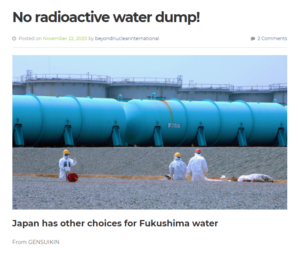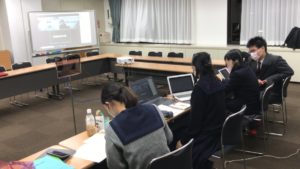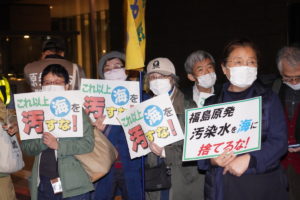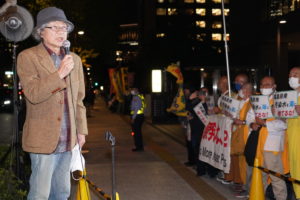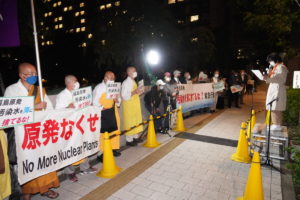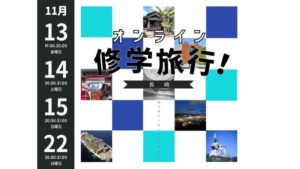11月, 2020 - 原水禁
2020年11月25日
12月1日 福島課題に関する立憲野党との意見交換会を行います

10月中に予定されていた政府関連閣僚会議による福島汚染水放水決定は、強い反対を受けて延期されていますが、予断は許されない状況が続いています。
政府による独断的な決定を許さないように、立憲野党への要請を行うため、院内集会を行います。
◆当日はツイキャス配信致します。こちらのツイート画面からご視聴いただけます。
開会5分前から、配信を開始いたします。
<立憲野党との意見交換会>
日 時 : 12月1日(火)
開場17:30 開会18:00~19:15 17:45~18:30
会 場 : 衆議院第一議員会館 大会議室
出席野党:(要請先・予定)
立憲民主党、社民党、共産党、沖縄の風ほか
集会内容: ①主催者あいさつ(鎌田慧さん)
②喫緊の福島課題(特に汚染水問題)を中心に要請します。
主 催 : さようなら原発1000万人アクション
電話 03-5289―8224(原水禁・井上)
その他 : ①17:30より、衆議院第一議員会館ロビーにて通行証を配布します。
②感染症防止のため、必ずマスクないしフェイスシールドの着用をお願いします。また、体調のすぐれない方は、参加をご遠慮ください。
③当日はネット(ツイキャス)配信を行います。
2020年11月24日
海外での「トリチウム汚染水海洋放出反対する原水禁からの呼びかけ」についてご紹介

海外のNGO団体 Betond Nuclear International が、原水禁が呼びかける「トリチウム汚染水放出反対」のキャンペーンの全文を掲載し、取り組みを紹介してくれています。
ホームページの掲載など、キャンペーン開始から数日で、海外各地から「No radioactive water dump!」の声が数多く届けられています。
今回のキャンペーンでは、原水禁大会でも講師を務めていただいた「核なきマンハッタン計画」の井上まりさんにもご協力いただいています。
第3分科会 福島原発事故の今と原子力政策 米国における脱原発の動向 井上まり(核なき世界へのマンハッタン計画)
2020年11月20日
「トリチウム汚染水の海洋放出に反対する署名」提出報告
全国の多くの皆様のご協力により、沢山の署名を提出する事が出来ました。
ありがとうございました。
現在もなお、署名が届いておりますので、更に積み上げて第3回目の署名提出を計画して参りたいとと思っております。
経済産業省への署名提出の様子は、「2020原発のない福島を!県民大集会」ホームページでご覧いただけます。
⇒こちらをクリック
| 「トリチウム汚染水の海洋放出に反対する署名」 |
|
|
2020年8月27日提出済
|
203,389筆 |
|
2020年10月2日提出
|
224,655筆 |
|
合 計
|
428,044筆 |
トリチウム汚染水の提出署名数報告(PDF)
トリチウム汚染水の海洋放出に反対するオンライン署名の取り組みについて
海外での「トリチウム汚染水の海洋放出に反対するオンライン署名の取り組み」についてご紹介
「トリチウム汚染水の海洋放出に反対する署名」への賛同をお願いします
2020年11月18日
12/14現在 経過報告はこちら
Japan Congress against A- and H-Bombs(GENSUIKIN)

“Say NO to the dumping of Fukushima’s radioactive water to the Pacific Ocean!”
Urgent Call for Action from Japan Congress against A- and H- Bombs (GENSUIKIN)
Dear friends,
The Japanese government has been ready to dispose radioactive water from the crippled Fukushima Daiichi nuclear power plant contaminated by tritium and other radioactive materials to the Pacific Ocean. We, GENSUIKIN, would like to ask you for your support to prevent this reckless attempt by the government.
- Please send us your comments criticizing the Japan’s plan to us (e-mail: gensuikin.online@gmail.com) by January 31st 2021. We will submit your comments when we will have negotiation with the Japanese government requesting to halt the disposal.
- Please also reach out to your elected officials and request that they send a message to the Japanese Consulate or Embassy in your area. The Science, ICT, Broadcasting and Communications Committee of the National Assembly of the Republic of Korea has already passed a resolution requesting that the Japanese government establish safer measures when processing the contaminated water.
Sincerely yours,

Tomoyuki Kitamura
General Secretary
Background
We have struggled against any uses of nuclear technology by any country, including the commercial use of nuclear energy such as nuclear power plants, on the basis of thought that “nuclear and humanity cannot coexist”. As you may know, on March 11, 2011, in the Great East Japan Earthquake, four of six nuclear reactors operated by Tokyo Electric Power Company (TEPCO) had core meltdowns caused by loss of cooling power. Due to the high radiation dose at the facility – 42 Sv in the containment vessel and 5150 mSv in the buildings –in it is impossible to grasp the situation of the core while cooling water is being injected to prevent criticality. In such a situation, it is seriously dangerous for cooling water to be contaminated by high-level radioactive materials and accumulated to approximately 1.23 million cubic meter and possibly leak into the groundwater.
After decontamination by an Advanced Liquid Processing System (ALPS), the contaminated water is stored in tanks at the nuclear site. At present, there are 1044 tanks at the site. Astonishingly, to remove the contaminated water, the Japanese government and TEPCO plan to dispose of it by dumping it into the Pacific Ocean. In pointing out the below problems, we organize opposition movements in solidarity with residents in Fukushima.
- Hitachi’s Advanced Liquid Processing System (ALPS) is not able to eliminate radioactive materials completely, especially tritium.
ALPS is supposed to eliminate other radioactive materials, however, in August 2018 Japanese media reported that it had consistently failed to eliminate a variety of other radioactive elements, including iodine-129, ruthenium-106, and strontium. It has been revealed that, in 70% of the tanks, the amount of radioactive substances present is 20,000 times the standard. TEPCO promises it will conduct secondary processing to lower the amount of radioactive substances to below standard level, but still has yet to keep its promise; thus the disposal of the contaminated water is still a dangerous act. Tritium cannot be eliminated by ALPS at all, TEPCO estimates that there is 860 trillion becquerel of tritium in the contaminated water as a whole.
There are varied opinions on how hazardous tritium is. It is often pointed out that tritium absorbed through food has negative effects on cells and damages DNA. TEPCO claims that it will dilute tritium-contaminated water to below standard level and dispose of it into the ocean; however, the absolute quantity of tritium in the water has not changed, and it is pointed out that tritium’s dangerous effects of bioaccumulation of radioactive material on fish can be seen throughout the food chain.
- The disposal of contaminated water to the ocean violates international law; for example, article 207 and article 213 of the United Nations Convention on the Law of the Sea, as well as article 1 and article 4 of the Convention on the Prevention of Marine Pollution by Dumping of Wastes and Other Matter of 1972 and article 4 of the 1996 Protocol to the Convention on the Prevention of Marine Pollution by Dumping of Wastes and Other Matter, 1972(London Protocol: LP).
The “United Nations Convention on the Law of the Sea” requests that “States shall adopt laws and regulations to prevent, reduce and control pollution of the marine environment from land-based sources” in article 207. The Convention on the Prevention of Marine Pollution by Dumping of Wastes and Other Matter of 1972 and London Protocol: (LP) forbid dumping any concentration of radioactive material into the sea. However, insisting that “discharge” is different from “disposal”, the Japan Atomic Energy Commission (JAEC) tried to approve dumping into the ocean without consensus. As Russia disposed of 900 cubic meters of low Level radioactive waste liquid on October 6th, 1993, the JAEC decided that Japan would hereafter not have the option to dispose of low level radioactive waste into the sea. GENSUIKIN regards the disposal of Fukushima contaminated water to the ocean as a violation of international law, and breaking the promise made to international society to abandon the disposal of wastes into the ocean.
- Japanese government and TEPCO abandon seeking other measures dealing with the contaminated water. They choose only dispose it to sea as it is the easiest and cheapest measure.
TEPCO argues that it will become too difficult to store the contaminated water due to a shortage of land required for holding tanks. However, it seems that they are making no effort to get land. There are areas which are difficult to inhabit due to contaminating radioactive materials disposed by the nuclear accident in Fukushima while there is some more usable land in the nuclear power plant sites. Furthermore, there are more options for keeping space for the holding tanks. One such option is to use technology such as “Grease Solidification”, first implemented in the Savannah River Site Disposal Facility in U.S., which solidifies highly tritium-contaminated water to be buried. TEPCO and the Japanese government have not considered these costly resolutions at all and have maintained disposal to sea as the only option. It is not acceptable.
- In August 2015, in responding to a request from Fukushima Prefectural Federation of Fisheries Co-operative Associations stating that “After the processing of radioactive contaminated water by ALPS, TEPCO is responsible for holding it in tanks in the nuclear power plant sites and must not dispose of the water into the sea without consent from fisheries and Japanese people”, TEPCO stated that “Without agreement from stakeholders, we will not dispose of any water and after processing by ALPS, the water will be held in the tanks at the site”. The disposal of water into the sea is an act of betrayal to the fisheries.
Japan Fisheries Cooperatives and Fukushima Prefectural Federation of Fisheries Co-operative Associations has unanimously passed a resolution stating that “they firmly oppose the disposal of contaminated water into the sea”. Moreover, Fukushima Prefecture Federation of forestry cooperatives and Central Union of Agricultural Cooperatives strongly oppose the disposal as well. Nineteen local assemblies in Fukushima Prefecture have submitted a written opinion opposing the disposal. There is no agreement on the disposal among stakeholders which is a precondition of TEPCO’s promise to implement the disposal. TEPCO must not force the disposal.
As we explain above, there are many problems about the disposal of contaminated water into the Pacific Ocean, therefore, there are no international and national agreements about it. In facing strong opposition to the disposal, the Japanese government postponed a cabinet council decision implementing the disposal which was expected to be decided last October. There is strong opposition abroad. Whether the Japanese government is forced to abandon the disposal depends on opposition from public opinion. GENSUIKIN would like to do our best in having the government abandon the disposal
GENSUIKIN World Conference -Fukushima-
Fukushima Conference printout focus on the disposal of contaminated water
GENSUIKIN:
Japan Congress Against A and H-Bombs (GENSUIKIN) was established in 1965, and it is one of the largest anti-nuclear and peace organizations in Japan. GENSUIKIN has local organizations as members, consisting of labor unions, women’s organizations, youth organizations and civil society groups in all 47 prefectures of Japan.
GENSUIKIN has public meetings annually in Yaizu-city in Shizuoka Prefecture since Yaizu-city was the mother port for the “Lucky Dragon No. 5” whose crew suffered from nuclear fallout resulting from the nuclear test in Bikini Atoll in 1954. The anti-nuclear movement in Japan emerged from the nuclear suffering caused by nuclear tests. There was a huge signature-collecting campaign demanding to ban nuclear weapons. Not only progressive and liberal political groups, but also conservative community organizations, participated and led the campaign which became a huge national movement.
Through the movement, the miserable reality of Hiroshima and Nagasaki caused by nuclear bombings in 1945 was revealed to Japanese people, and the voices of the citizens of Hiroshima and Nagasaki requesting to ban nuclear weapons were heard over Japan. The humanitarian consequences of Hiroshima and Nagasaki triggered a strong national movement to eliminate nuclear weapons.
GENSUIKIN conference is held in Hiroshima and Nagasaki in August annually to commemorate the atomic bombings. After the Fukushima Daiichi nuclear accident in 2011, we now have additional GENSUIKIN conferences in Fukushima to achieve nuclear phase-out as well.
Nuclear Phase-out
GENSUIKIN actively makes efforts to achieve nuclear phase-out and we firmly believe that “nuclear and humanity cannot co-exist”. In fact, and unfortunately, the Fukushima-Daiichi nuclear accident and the Chernobyl nuclear accident demonstrate there are disastrous consequences if a nuclear power plant is broken down by any cause. While we argue for the decommissioning of nuclear power plants systemically, we demand that energy policies be changed to promote renewable energy. We support and collaborate with people suffering from Fukushima-Daiichi nuclear accident, including those forced to evacuate for a long time.
Abolition of Nuclear Weapons
We have pursued steady steps to abolish nuclear weapons. It is important to change the policy of the Japanese government whose first priority is to remain protected under the nuclear umbrella of the United States, as well as to persuade the five nuclear-weapon states in NPT and other nuclear states outside of it to abolish nuclear weapons. The Japanese government in particular has already accumulated huge amounts of plutonium been trying to establish a nuclear fuel cycle by building reprocessing plants in Japan. We demand that the Japanese government not rely on nuclear security and abandon the nuclear fuel cycle plan to demonstrating morality as a country suffered from a nuclear attack to appeal to the abolition of nuclear weapons.
Solidarity with Hibakusha
It is important to support Hibakusha (atomic bomb survivors) regarding their health and living and it is critical to share their experiences and pass them down to younger generations. Thus we are closely cooperating with the second and third generations of Hibakusha to support their activity. At the same time, since there are a huge number of Hibakusha all over the world who continue to suffer from past nuclear tests, uranium mining and nuclear accidents, it is important to strengthen our collaboration with them. We invite Hibakusha from all over the world, such as the South Pacific, to GENSUIKIN conference to share our experiences..
Member Organizations of GENSUIKIN:
All-Japan Prefectural and Municipal Workers Union(JICHIRO)
Japan Teachers’ Union(JTU)
General Federation of Private Railway Workers’ Unions of Japan(PRU)
All Japan Water Supply Works Union
Japanese Federation of Forrest and Workers Union(JFFWU)
National Federation of Automobile Transport Workers’ Unions
Japan broadcasting labour Union
LAFGO (Labor Federation of Government Related Organizations)
All Printing Bureau Labour Union
National Railway Workers’ Union(NRU)
All Japan Dockworker’s Union (JDU)
Japan Construction and Transtry Workers’ Solidarity Union(CTSU)
Japanese Health Care Workers’ Union (JHU)
Japan Community Union Federation(JCUF)
National Union of General Workers
All-Japan Farmers Federation
Buraku Liberation League
League of Socialist Youth
Social Cultural Legal Center
Japan Women’s Council
Consumers Union of Japan
2020年11月17日
11月13日~15日 高校生1万人署名活動が「オンライン修学旅行」を開催しました

東京の高校生平和大使および高校生1万人署名活動を中心に、コロナ禍で修学旅行がなくなり平和学習の機会を失った学生のために、「オンライン修学旅行」と題した、長崎への修学旅行を体験できるオンラインイベントが開催されました。
コロナ禍で修学旅行の取りやめを決定する学校が多くあります。広島や長崎への修学旅行は平和を考えるきかっけになる、大切な機会であると考えた高校生が、「長崎への修学旅行」を通して、平和の大切さを訴えました。
当日のオンラインでの参加者は中高生に限定し、初日は、長崎で被爆された山川剛さんによる被爆講話を聞き、質疑応答に重きを置くなど、双方向のやり取りを重視したものとなりました。
二日目は「長崎バーチャルツアー」と題し、長崎の高校生が撮影した画像を、東京の高校生が写真や地図を組み合わせ、ナレーションを付けて、フィールドワークが体験ができるような動画を作成し、公開しました。平和公園、祈念館、如己堂のほか、グラバー園や教会群などの観光地をめぐる動画もあり、気軽に長崎のことを学べる内容となっています。
三日目は、長崎大学の広瀬教授に「核兵器をめぐる問題」をわかりやすく講義していただきました。核兵器禁止条約の発効を2021年1月22日に控え、現存する核兵器の数を導入に、どのようにして軍縮を進めていくか、核抑止力の矛盾など、様々な問題点を学ぶことが出来ました。
修学旅行という設定から、学びの面だけではなく、長崎の食事や行事など楽しめるコンテンツを盛り込むとともに、バーチャルツアーを見ながらチャットでの交流を行うなど、友人たちと楽しく旅行している気分を味わってもらえるような工夫がなされています。
初日、二日目の本編のあとには、「消灯前自由時間」と題して、より修学旅行気分を味わってもらえるような「高校生らしい」カードゲームをオンラインで楽しむなど、修学旅行の夜さながらの企画となりました。
「修学旅行に行けない中高生」へむけて企画されたものですが、被爆証言や核兵器問題の講義など、どなたでも学べる内容となっています。
現在、「高校生1万人署名活動東京支部」のYouTube公式チャンネルに「オンライン修学旅行」三日間の動画を公開していますので、是非ご覧ください。
11/13(金)山川剛さん 被爆講話
11/14(土)長崎バーチャルツアー(5本の動画で構成されています)
11/15(日)長崎大学教授 特別講義
また、オンライン修学旅行本編に先立ち、同YouTube公式チャンネルでは、被爆証言やビブリオバトルなどの事前学習動画を公開しています。併せてご覧ください。
また、22日には、これまでの参加者に希望者を加え、事後学習企画を行います。平和に関するテーマをもとに、ディスカッションを行い、修了証を授与します。参加ご希望の方は、Googleフォームにてお申込みください。
お申し込みはこちらから➡【申込フォーム】
◆東京支部ホームページ・ブログ
http://10000signaturetokyo.ml
◆Instagram
https://instagram.com/tokyosignature
◆Facebook
https://facebook.com/pages/category/Community/tkypeacesgntrs/about/
◆Twitter
https://twitter.com/tokyosignature
◆「高校生一万人署名活動東京支部」YouTube公式チャンネル
https://www.youtube.com/channel/UC81ej9PEiEewGS3NlTVVtBg
2020年11月15日

10月27日(火)午後6時から衆議院第二議員会館前で「さようなら原発1000万人アクション実行委員会」が主催して「福島原発汚染水を海に捨てるな!緊急行動」が行われ、170名が参加しました。
司会者が「汚染水廃棄の決定は本日延期になったが、これまで以上に運動を強めないといけない」と開会を告げました。
まず主催者を代表し、呼びかけ人でジャーナリストの鎌田慧さんが発言に立ちました。
「福島での住民、漁民の皆さんの汚染水廃棄に対する怒りが、全国に広がりつつある。全世界に影響する環境汚染であり、国際的にも運動を作り上げていきたい。菅政権は論理も倫理もない、何をするかわからないが、私たちは海洋投棄を許さない闘いを強めて行こう」という決意を明らかにしました。

続いて「原発の無い福島を!県民大集会実行委員会」から副実行委員長の滋賀一幸さんが、福島現地での動きと取り組みを報告し、政府を決定できないところに追いこんでいるが、厳しい状況は続いている、さらに運動を強めて行こうと呼びかけました。
その後、現地から送られた「これ以上海を汚すな!市民会議」のメッセージが読み上げられました。
続けて「FoEジャパン」の満田夏花さん、「原子力資料情報室」から片岡遼平さん、「原発ゼロ基本法案事務局」から山崎衆議院議員と福島参議院議員、「原発をなくす全国連絡会」の木下興さん、「再稼働阻止全国ネットワーク」の木村雅英さん、「ふぇみん婦人民主クラブ」から片岡英子さんが発言し、海洋投棄阻止への決意を明らかにしました。
また原水禁の北村智之さんが北海道の高レベル廃棄物中間貯蔵施設の問題で、「文献調査」に手を挙げた自治体への申し入れ行動を行ったことを報告しました。

海洋投棄阻止への決意を再度確認し、集会は終了しました。
2020年11月17日
「止めよう再処理!100万人署名」の取り組みの強化について
「止めよう再処理¡100万人署名」の取り組み強化についてのお願いです。
すでに各地、各団体において取り組みをすすめていることと存じますが、新型コロナウイルス感染症の拡大が続き、署名運動の展開が厳しく、街頭などでの取り組みも困難な中にあると思いますが、今回あらためて取り組みの強化をお願い致します。
核燃料サイクルについては、菅新政権は先の衆議院予算委員会(11月4日)で、「核燃料サイクル政策を推進する」ことを基本的方針と述べた上で、再処理工場の完工、プルサーマル発電の推進、使用済みMOX燃料の再処理の研究開発などの政策を進めると言明しています。
しかし、原発や核燃料サイクルをめぐる環境は大きく変わり、原発の新増設は進まず、むしろ原発の廃炉が相次いでいます。まさに原発は「廃炉の時代」を迎えています。核燃料サイクルも、中心となるべき高速増殖炉は、原型炉「もんじゅ」の開発が廃炉となり、フランスなどとの高速炉開発もとん挫しました。プルトニウム消費のためのプルサーマル計画も低調なまま先行きが不透明となっています。核燃料サイクルは、実現性もなく政策的にも破綻しているのが現状です。
安倍政権を引く継いだ菅政管も、原発・核燃料サイクル路線を進め、国際的にも問題となっている温暖化対策に原発を活用しようとしています。破綻が明らかな核燃料サイクル路線からの撤退を求め、脱原発に向けた政策転換をはかるためにこの署名に引き続きご協力をお願い致します。なお、署名展開に役立つ冊子「STOP!再処理―六ヶ所再処理工場を動かしてはいけない10の理由」も併せてご活用ください。
記
止めよう再処理!100万人署名
1.要請先
内閣総理大臣/経済産業大臣/原子力委員会/原子力規制委員会
2.要請項目
- 原子力政策、核燃料サイクル政策の根本的転換を求めます。
- 六ヶ所再処理工場、MOX加工工場、むつ使用済み核燃料中間貯蔵施設、世界初の大間フルMOX原発の建設中止を求めます。
- プルトニウム利用政策の放棄を求めます。
- プルサーマル計画の中止と第二再処理工場計画の放棄を求めます。
- 下北半島を核のごみ捨て場にしないことを求めます。
- 原子力政策、核燃料サイクル政策について公開討論会を求めます。
3.呼びかけ団体
止めよう再処理!100万人署名実行委員会
原水爆禁止日本国民会議・原子力資料情報室・核燃サイクル阻止1万人訴訟原告団
核燃料廃棄物搬入阻止実行委員会・反原発運動全国連絡会・青森県反核実行委員会
4.目標数 100万筆
5.締め切り 2021年3月31日
6.送付先 青森県反核実行委員会
〒030-0811 青森県青森市青柳1-3-14
℡ 017-776-5665
7.教宣資材 学習小冊子(A5判・24頁)を作成しました。ご活用ください。
「STOP!再処理―六ヶ所再処理工場を動かしてはいけない10の理由」
はんげんぱつ新聞編集部・著
頒価 1冊200円・送料別
*申込書はこちら
8.その他
①青森県反核実行委員会からの呼びかけ PDFはこちら
②署名用紙は、PDFデータを印刷してください。 PDFはこちら
なお、大量に必要な場合は、原水禁事務局へご相談ください。
2020年11月12日
民意を無視し、強引に女川原発再稼働を進めることを許すことはできません。
原水禁は、抗議声明を発しましたので、ここにお知らせ致します。
女川原発2号機再稼働に対する地元同意に強く抗議する
11月11日、東北電力女川原子力発電所2号機の再稼働について、宮城県、石巻市、女川町の地元三自治体の首長が「再稼働の同意」を表明した。村井嘉浩宮城県知事は、11月16日以降梶山弘志経済産業相に同意する考えを直接伝えるとされているが、「再稼働の同意」は県民の総意とは考えられない。
東北電力女川原発は、2011年3月11日の東日本大震災に際して、5系統ある外部電源のうち4系統が失われ、残った1系統により大惨事を免れたが、場合によっては全電源喪失の事態も考えられた。重油タンクの倒壊や原子炉建屋への浸水被害、タービン周辺の損傷を受けるなど、被災した原発である。住民を放射能から守る拠点施設となるはずの原子力防災対策センターや宮城県原子力センター、モニタリングステーションも地震と津波により破壊された。女川原発2号機は、東日本大震災に際して過酷事故を起こし、福島県および周辺地域に大量の放射性物質を放出し、今なお、事故の収束もままならない福島第一原発と同じ沸騰水型原子炉(BWR)の「マークⅠ改良型炉」である。安全性に関しては、福島第一原発事故の調査結果を踏まえる必要があり、福島原発事故の全容が明らかになっていない中での同型の原発の再稼働は、多くの不安材料を残している。そもそも新規制基準は、現時点での知見に基づく基準に他ならず、将来的な「安全」を保障したものでないことは、原子力規制委員会が度々繰り返し発言している。女川原発はひずみが集中するプレート境界線に立地し、地震や津波のリスクの高さが指摘され、過去三度想定を超える地震動により揺さぶられた被災原発であり、原発建屋や原子炉などの剛性劣化が指摘される。国の地震調査研究本部の「日本海溝沿いの地震活動の長期評価」によれば、宮城県沖のプレート間巨大地震の発生確率は、今後30年で20%とされているが、M7.0~7.5程度のひとまわり小さいプレート間地震は、今後30年間で90%の確率を示している。研究者の中には、明治三陸沖地震と37年後の昭和三陸沖地震との関連から、東日本大震災の余震としてのアウターライズ型地震が今後予想されるとの指摘もあり、予断を許さない状況にある。そのような中で再稼働を認めることは、地域住民の安全の軽視と言わざるを得ない。
菅首相は、再稼働に際し、「しっかりした避難計画がない中で、再稼働が実態として進むことはない」と国会答弁をしているが、女川原発周辺30km圏の緊急防護措置区域(UPZ)の住民や自治体は、避難計画の実効性を不安視している。地震や津波などにより孤立や通行不能などの事態に陥ることは東日本大震災で経験しており、避難路の整備の必要性については国や東北電力も認めているが、その見通しは立っていない。原発に近い寄磯地区は、陸路では避難時に原発を通らざるを得ない。安全性の高い道路整備は計画されず、住民の安全を軽視したまま再稼働を決定している。30km圏内も含め一斉避難の場合、5km圏内の約3,500人が避難するのに5日間はかかるとの宮城県の試算もある。
宮城県の広域避難計画は、原発30km圏の約20万人が県内31市町村に避難する内容だが、受け入れ先の首長も含めその実効性に疑問を呈している。広域避難計画は、複合災害を想定したものであり、受け入れ自治体は「複合災害時は自らの住民の避難に専念する」としており、県内避難のみで実効性ある避難計画を作り上げることは物理的に困難である。しかしながら村井知事は「訓練を積み重ねることで実効性を担保する」とし、東電福島第一原発事故の反省の上に義務付けられた「広域避難計画」を、一貫して再稼働の同意要件から切り離す姿勢にあることは、住民の命を軽視するなにものでもない。
宮城県議会は、世論調査で県民の8割が賛成していた再稼働の是非を巡る「県民投票条例案」を2019年の議会で否決しながら、2020年9月議会でも徹底した審議をすることなく「再稼働推進」の請願を採択し「再稼働の地元同意」を後押ししてきたことは、民主主義とは言えない行為と言わざるを得ない。
村井知事は、11月9日、市町村長会議を開催し、再稼働に「賛成」「反対」も含めさまざまな意見が首長から示されたが、「近く開催する女川町長、石巻市長との三者会談での結論を、全ての市町村長の総意とする」と提案し、11月11日の地元同意に至ったものであり、県民はもちろん、原発立地周辺自治体や住民の声を反映したものではない。
また、村井知事と立地2市町長は東北電との安全協定に基づき、原発施設の新増設に対する「事前協議」も了解する方針である。これにより、東北電力は2号機で格納容器の破損を防ぐフィルター付きベント(排気)装置を運用するための追加工事など行う事が可能となるが、宮城県においても東電福島第一原発の放射能漏れ事故による農林系廃棄物や指定廃棄物の処分を巡り、現在も住民と自治体が対立するなど不幸な事態も招いており、放射能を生活圏に放出することを義務付けた新規制基準を人道的に許すことはできない。
村井知事は、記者会見で「原発は安定した電力供給に優れており、地域経済の発展にも寄与する」と述べているが、福島原発事故の反省に何ら立っていない。福井地裁の樋口英明裁判長は、大飯原発差し止め訴訟の判決で「豊かな国土とそこに国民が根を下ろして生活していることが国富であり、これを取り戻すことができなくなることが国富の喪失であると当裁判所は考えている」と述べた。そのことの意味をしっかりと受け止めなくてはならない。
再稼働に向けた女川原発の安全対策工事は2022年度まで続く。私たちは、県民の命と安全を守る立場で被災原発の再稼働に反対し、廃炉を求めていく。
2020年11月12日
原子爆禁止日本国民会議
議長 川野浩一
2020年11月02日
高校生1万人署名活動・東京支部主催で「オンライン修学旅行」を開催します!

東京の高校生平和大使および高校生1万人署名活動を中心に、コロナ禍で修学旅行がなくなり平和学習の機会を失った学生のために、「オンライン修学旅行」と題し、長崎への修学旅行を体験できるオンラインイベントを企画しました。
「オンライン修学旅行」
日 時:11月13日(金)19:00~20:00、
14日(土)20:00~21:00、
15日(日)20:00~21:00
視聴方法:YouTube公式チャンネル「高校生一万人署名活動東京支部」
参加申し込み:こちらから(googleフォームを利用)
主 催:高校生1万人署名活動東京支部
◆東京支部ホームページ・ブログ
http://10000signaturetokyo.ml
◆Instagram
https://instagram.com/tokyosignature
◆Facebook
https://facebook.com/pages/category/Community/tkypeacesgntrs/about/
◆Twitter
https://twitter.com/tokyosignature
◆YouTube公式チャンネル
https://www.youtube.com/channel/UC81ej9PEiEewGS3NlTVVtBg
これまでに事前学習企画として、以下の動画を配信しています。
オンライン修学旅行 事前学習① ビブリオバトル
北海道や奈良県の高校生平和大使も書評を発表しています。企画・収録・編集まで、すべてを高校生が運営しています。
動画をご覧いただくとともに、書評発表の投稿(いいねボタン)にご協力ください。
オンライン修学旅行 事前学習② 被爆者講話
日本テレビ系情報番組「バンキシャ!」さんにご協力をいただき、8月1日にお話を伺った、木村徳子さんの被爆証言です。
被爆証言のポイントを話し合い、高校生自身で編集を行っています。
第23代平和大使について
1998年に活動が開始された高校生平和大使は、2020年には第23代となり、全国16都道府県28人というこれまでで最多の選出となりました。2018年より3年連続でノミネートされたノーベル平和賞の受賞はかないませんでしたが、戦争の惨禍を伝え核兵器の廃絶をめざす若者の活動として注目されています。新型コロナウイルス感染症の影響を受け、欧州訪問や結団式も中止となり、各選出地で個別の認証式を行いました。
これまで活動の中心であった「高校生1万人署名活動」は、街頭での実施が難しい地域もあり、デジタル署名を開始しました。
デジタル署名
そのほか、第23代平和大使共通の平和宣言を作り、194ヶ国と地域の世界の指導者へ送付する「高校生平和大使プロジェクト」を行います。
今後も、「微力だけど、無力じゃない」を合言葉に、新型コロナウイルスの状況を見ながら、核廃絶へ向けた各地域での活動、オンラインでの活動など、実行できるものを模索しています。
TOPに戻る
